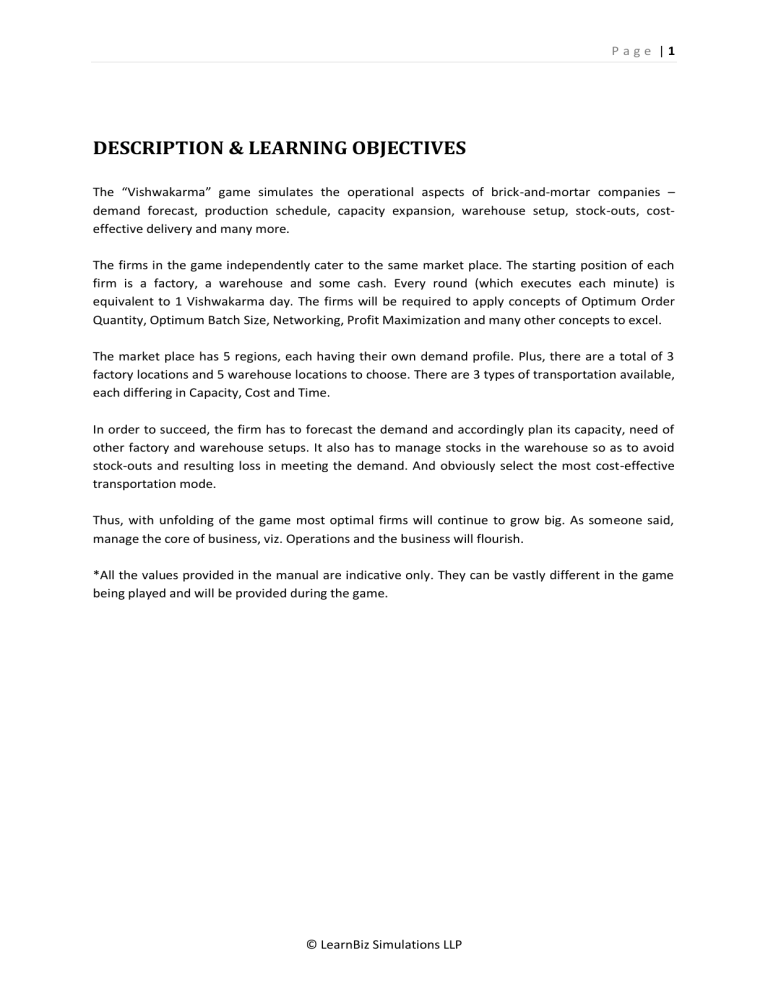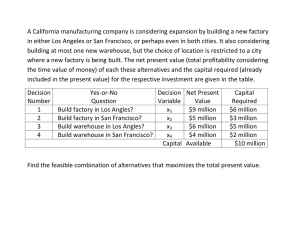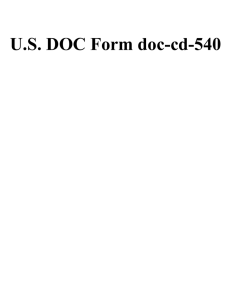
P age |1 DESCRIPTION & LEARNING OBJECTIVES The “Vishwakarma” game simulates the operational aspects of brick-and-mortar companies – demand forecast, production schedule, capacity expansion, warehouse setup, stock-outs, costeffective delivery and many more. The firms in the game independently cater to the same market place. The starting position of each firm is a factory, a warehouse and some cash. Every round (which executes each minute) is equivalent to 1 Vishwakarma day. The firms will be required to apply concepts of Optimum Order Quantity, Optimum Batch Size, Networking, Profit Maximization and many other concepts to excel. The market place has 5 regions, each having their own demand profile. Plus, there are a total of 3 factory locations and 5 warehouse locations to choose. There are 3 types of transportation available, each differing in Capacity, Cost and Time. In order to succeed, the firm has to forecast the demand and accordingly plan its capacity, need of other factory and warehouse setups. It also has to manage stocks in the warehouse so as to avoid stock-outs and resulting loss in meeting the demand. And obviously select the most cost-effective transportation mode. Thus, with unfolding of the game most optimal firms will continue to grow big. As someone said, manage the core of business, viz. Operations and the business will flourish. *All the values provided in the manual are indicative only. They can be vastly different in the game being played and will be provided during the game. © LearnBiz Simulations LLP P age |2 DESCRIPTION OF GAME DECISIONS The firm starts with a single factory (capacity of 80 units per day) and a warehouse (with no inventory) and Rs. 200,000 as cash. Factory There are 3 locations where a factory can be set up. At the start of the game, you have a factory at one of the locations. A new factory can be setup at other locations. The time taken to build a new factory is 40 days and the minimum daily capacity should be 30 units. The fixed cost of a new factory setup is Rs. 100,000 and variable cost is Rs. 5,000 per unit. A capacity expansion can be scheduled at any factory setup. The time taken to build new capacity is 25 days. The variable cost is Rs. 5,000 per unit. Please note that at a time; only one capacity expansion can take place at a factory. The cost of production of one unit is only Rs. 10 as compared to selling price of Rs. 600. A factory has storage capacity of only 200 units. If the finished units at the factory exceed 200 units, then an inventory holding cost of Rs. 5 per additional unit per day will have to be incurred. Warehouse There are 5 locations where a warehouse can be set up. At the start of the game, you have a warehouse at one of the locations. A new warehouse can be setup at other locations. The time taken to build a new warehouse is 15 days. The fixed cost of a new warehouse setup is Rs. 50,000. The warehouse has unlimited capacity but it costs Rs. 5 per unit per day to keep the stocks. Demand Profile of the Regions Region A – Delhite – Their consumption pattern is akin to spikes every 30 days. It is as if they spend everything when they get a salary. The demand varies between 250 and 300 units per day for a period of 4 days every 30 days. Region B – Bangloorian – Their consumption pattern is like a staircase. It is as if a newer capacity addition is taking place every now and then. The starting demand is 5 units per day, increasing by another 5-6 units after every 30 days. Region C – Chenniamma – Their consumption pattern is seasonal. It is more like a sine curve – starting from 0, reaching the crescendo and then falling back to 0. The peak demand is around 30 units per days. A season in Vishwakarma world is 60 days long. Region D – Kolkattan – They have a constant consumption pattern. It is as if the business cycle does not exist. The daily demand is anything between 40-50 units. © LearnBiz Simulations LLP P age |3 Region E – Mumbaiya – Their consumption pattern is like a slope. It is as if everyday someone comes there to stay permanently. The starting demand is 30 units per day and increases at a rate of 3 units every 4 days. Transportation There are 3 types of transportation modes available – Flight, Truck, Pick-Up. A unit of delivery through flight costs Rs. 400. Also, Flight has a minimum batch size of 50 if flown from remote locations. A unit of delivery through truck costs Rs. 50. Also, Truck has a minimum batch size of 200 if used in remote locations. A unit of delivery through pick-up costs Rs. 150. Also, Pick-Up has a minimum batch size of 100 if used in remote locations. The delivery from Factories can only be done by Flight or a Truck. Also, a minimum batch size is applicable to deliveries from factories. The delivery from Warehouses can be done by Flight or Truck or a Pick-Up. There is no minimum batch size applicable to deliveries from warehouses. Time (in days) from Factory Location to Warehouse Location - Flight FA FB FC WA 1 1 1 WB 1 1 1 WC 1 1 1 WD 1 1 1 WE 1 1 1 Time (in days) from Factory Location to Warehouse Location - Truck FA FB FC WA 4 1 3 WB 3 1 4 WC 1 3 2 WD 2 2 1 WE 3 5 1 Time (in days) from Warehouse Location to Region Location - Flight WA WB WC WD WE RA 1 1 1 1 1 RB 1 1 1 1 1 RC 1 1 1 1 1 RD 1 1 1 1 1 RE 1 1 1 1 1 Time (in days) from Warehouse Location to Region Location - Truck WA WB RA 2 3 RB 3 2 RC 5 3 © LearnBiz Simulations LLP RD 3 3 RE 8 8 P age |4 WC WD WE 5 3 8 3 3 8 2 3 4 3 2 4 4 4 2 Time (in days) from Warehouse Location to Region Location – Pick-Up WA WB WC WD WE RA 1 2 3 2 4 RB 2 1 2 2 4 RC 3 2 1 2 2 RD 2 2 2 1 2 RE 4 4 2 2 1 *All values provided above are default. Actual values may be different. Check ‘About’ page within game for them. © LearnBiz Simulations LLP P age |5 DESCRIPTION OF GAME SCREENS The screen description is intended to give you a preview of what’s in store for you in the game. It is critical to clearly understand the screens here although there is no replacement of in-game practice. Area Map The Area Map gives you the location of active and non-active factories and warehouses. Also provided is the Cash In Hand alongwith the Current Time of the game. © LearnBiz Simulations LLP P age |6 Factory Dashboard In the factory dashboard, you can decide to start/stop production. And also prioritize the warehouses and the transportation to be used. The factory would automatically stop production if Cash-in-Hand becomes negative at any point of time. You would have to then manually re-start production when Cash-in-Hand becomes positive again. Min. Batch Size It is the minimum quantity which should be dispatched with the selected transport mode. Re-Order Point If the inventory levels at the associated warehouse falls below re-order point, then an order is placed with the factory. Re-Order Quantity When an order is placed with the factory, re-order quantity signifies the quantity which should be dispatched from the factory. © LearnBiz Simulations LLP P age |7 Warehouse Dashboard In the warehouse dashboard, you can decide on prioritization of the regions. © LearnBiz Simulations LLP P age |8 Graph (Warehouse v/s Time) The graph shows the inventory position in each warehouse every time period. Graph (Cash Position v/s Time) The graph shows the cash position every time period. © LearnBiz Simulations LLP P age |9 Graph (Lost Demand v/s Time) The graph shows the demand lost in every region every time period. Graph (Cash Breakup v/s Time) The graph shows the various cash components every time period. © LearnBiz Simulations LLP


